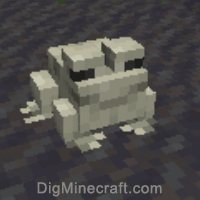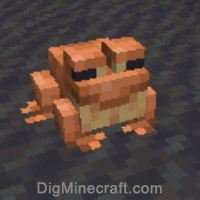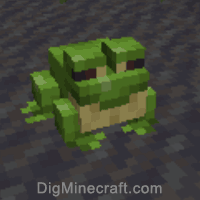NBT Tags for Frog in Minecraft (Java Edition 1.19/1.20)
This Minecraft tutorial explains the NBT tags (formerly called data tags) that you can use for a frog in Minecraft Java Edition (PC/Mac) 1.19 and 1.20.
Background
In Minecraft Java Edition 1.19 and 1.20, the entity value for a frog is frog. The frog entity has a unique set of data tags that can be used in Minecraft commands such as: /summon and /data.



What are NBT tags (formerly called Data Tags)?
NBT tags allow you to set certain properties of an entity (such as frog). The NBT tag is always surrounded in {} such as {variant:cold}. If there is more than one NBT tag used in a game command, the NBT tags are separated by a comma such as {variant:cold, CustomName:"\"Kermit\""}.
List of NBT Tags
Here is a list of the NBT tags that you can use for frog in Minecraft Java Edition (PC/Mac) 1.19 and 1.20:
| NBT Tag | Value (Description) | Works With |
|---|---|---|
| variant | cold (The frog is green) Example |
/summon /data |
| InLove | ticks (The number of game ticks that the frog is in love mode and will try to breed with another frog) Example |
/summon /data |
| CustomName | name (The name to assign to the frog) Example |
/summon /data |
| Health | number (The number of health points the frog has) Example |
/summon /data |
| AbsorptionAmount | number (The number of absorption health points the frog has) Example |
/summon /data |
| Invulnerable | 0 (The frog will take damage like normal) Example |
/summon /data |
| PersistenceRequired | 0 (The frog will despawn naturally) Example |
/summon /data |
| NoAI | 0 (The frog will have artificial intelligence and will move/behave like normal) Example |
/summon /data |
| Silent | 0 (The frog will make its usual noises in the game) Example |
/summon /data |
| Fire | ticks (The number of game ticks until the frog is no longer on fire - there are 20 ticks in a second) Example |
/summon /data |
| PortalCooldown | ticks (The number of game ticks until the frog can go through a portal again - there are 20 ticks in a second) Example |
/summon /data |
| Air | ticks (The number of game ticks the frog has air left for) Example |
/summon /data |
| id | frog (The entity value used to represent a frog in the EntityTag or Passengers tag) Example |
/summon /give |
| Passengers | The mob that is riding on the frog. Use the entity value for the passenger mob Example of bee as passenger |
/summon /data |
NBT Tag Examples
To summon a frog (ie: green frog):
/summon frog ~ ~ ~ {variant:cold}
To summon a green frog that is named Kermit:
/summon frog ~ ~ ~ {CustomName:"\"Kermit\"", variant:cold}
Target Selectors
Before we finish discussing data tags, let's quickly explore how to use the @e target selector. The @e target selector allows you to target entities in your commands. If you use the type=frog value, you can target frogs:
@e[type=frog]
Target Selector Examples
To change the nearest frog to a temperate frog (ie: orange frog):
/data merge entity @e[type=frog,limit=1,sort=nearest] {variant:temperate}
To kill all frogs:
/kill @e[type=frog]
Next, learn how to use the game commands in Minecraft.
Command Examples
Here are some game command examples for a frog in Minecraft:
Command Generators
If you need help, you can use these tools to automatically generate commands for you:
Advertisements








